Having products that your target customers need is not all that it takes to succeed as a dropshipper.
Your target customers still need to visit your site to view your products, read reviews, and place an order for the products they want to buy.
So, to convert web visitors who land on your dropshipping store and turn into customers, you’ll need to make a good first impression.
Your website navigation needs to be clear, your design free from clutter, your product images and promotional videos need to be captivating.
On top of that, you need to have verifiable trust signals like offers that align with what they’re looking for and a logistics process that is seamless and hassle-free.
If you’ve applied these elements to your store and you still feel like you can do more to boost your sales, then it's time to consider optimizing your conversion rate.
In this post, we will cover the basics of conversion rate optimization, when to use CRO tools, and share our favorite tools that you can use to collect data that will help you know what you need to do to make more sales.
Jump to:
- What Do Conversion Rate Optimization Tools Actually Do?
- Different Types Of CRO Tools
- When To Use Conversion Rate Optimization Tools
- 10 Conversion Rate Optimization Tools
What Is Conversion Rate Optimization?
Conversion rate optimization is a set of frameworks and tactics that help you make data-driven decisions to improve user experience to increase the number of conversions on your store.
It involves using tools to analyze different elements of user behavior, identifying areas where the user experience needs improvement, and implementing these changes in your store.
Conversion rate optimization also involves conducting A/B tests to compare two or more variations of web pages or elements such as offers, call-to-action buttons, or forms to see which variation converts more traffic into customers.
What Do Conversion Rate Optimization Tools Actually Do?
Conversion rate optimization tools offer a wide range of functionalities that can help you improve your store’s performance and drive conversions, helping you meet your KPIs.
-
A/B testing
A/B testing allows you to compare two versions of a webpage or element to determine which one drives more conversions.

CRO tools allow you to run controlled experiments and optimize various elements, such as headlines, call-to-action buttons, and layouts, based on real-time user feedback.
-
User behavior analysis
Once a web visitor lands on your ecommerce website, they interact with different elements such as your homepage, pop-ups, product pages, and your checkout process.
CRO tools provide you with heatmaps showing you the elements they pay more attention to on different pages. Here’s an example of a website heatmap tool from Hotjar:
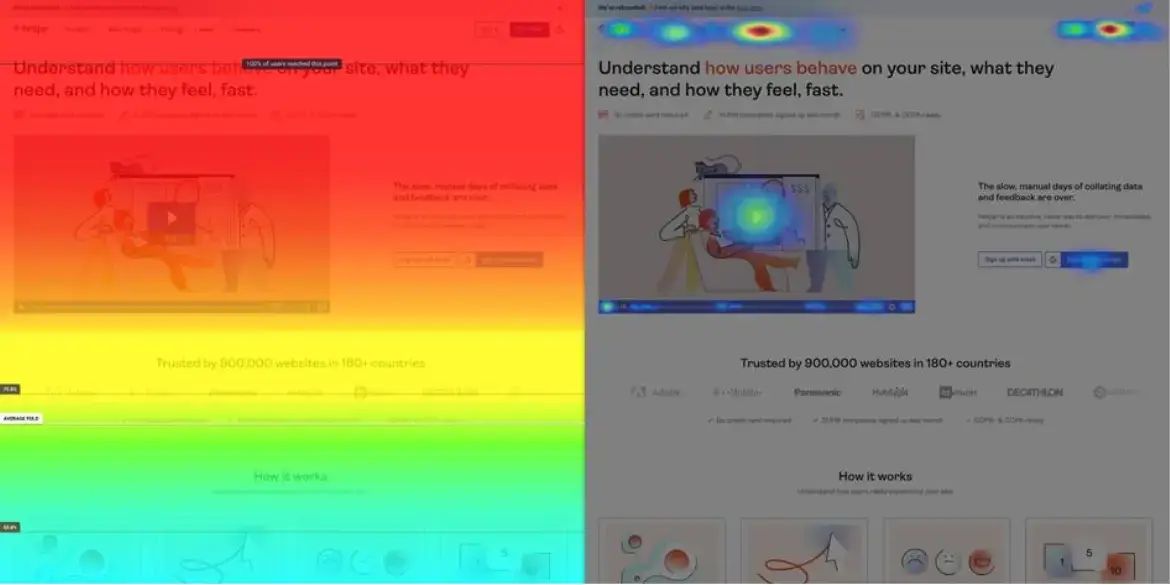
User behavior analysis tools help you see how users interact with these elements and what obstacles prevent conversions. This gives you insight into what you need to do to improve their experience in your store.
Different Types Of CRO Tools
-
A/B testing tools
These tools allow you to test different variations of your website or landing pages to see which one performs better.
Running experiments and analyzing the results you get allows you to make data-driven decisions on how to optimize your store to improve your conversion rate.
-
Heat mapping software
Heatmaps are a visual representation of how your website visitors behave in your store. They show you where they click, how far they scroll, and where they spend most of their time.
This valuable insight can help you identify areas for improvement and make informed design changes that will enhance the user experience and, ultimately, boost conversions.
-
User feedback tools
These tools allow you to run email or website surveys to collect feedback from web visitors.
The feedback you collect helps you identify what is affecting their user experience and preventing conversions, enabling you to implement the necessary changes.
-
Website analytics tools
These tools track key metrics such as bounce rate, average session duration, and conversion rates. These insights allow you to identify patterns and trends that can inform your CRO strategies.
When To Use Conversion Rate Optimization Tools
Low conversion rates: If you notice that a significant number of visitors are leaving your store without completing desired actions (such as making a purchase or signing up), you need a tool to help you identify specific pages where visitors land and the elements on these pages that are causing them to abandon the site.
A/B testing: When you want to compare different versions of your web pages or elements to see which one performs better, this is the path to take.
A/B testing involves creating two or more variations of a page and measuring their performance to determine which one yields higher conversion rates.
User experience issues: If your website visitors tell you that your navigation is confusing and they can't find what they are looking for, then you need a tool that collects data on user behavior to see how they behave in your store and the problems that get in their way.
For example, optimizing the checkout process is crucial. CRO tools can help you analyze user behavior during the checkout process and identify any hurdles that might be causing users to abandon their carts.
10 Conversion Rate Optimization Tools
- POWR.io
- Google Analytics
- VWO
- Mixpanel
- CartFlows
- Hotjar
- Optimizely
- Glassbox
- OptinMonster
- Heap Analytics
Several conversion Rate Optimization (CRO) tools are available that can help you analyze user behavior, run tests, and optimize your store to boost sales.
Take advantage of artificial intelligence and the technology available nowadays to improve your conversion rate. Here are some of our favorite CRO tools you might consider using:
1. POWR.io
POWR is a versatile online platform that allows you to create beautiful, fully customizable web apps that convert site visitors into customers.
POWR offers website widgets that allow you to create CRO tools such as forms, lead capture popups, live chat tools, surveys, and FAQs. These tools enhance functionality and engagement for websites across various industries.

POWR has an extensive library of pre-designed templates and a user-friendly drag-and-drop builder. This tool allows users to design and customize widgets to suit their specific needs, ensuring a personalized user experience.
There's also a robust analytics tool that allows users to track and measure the performance of their widgets, providing valuable insights into user interactions and engagement.
What's more, the plugins POWR provides can adapt to various website platforms, such as WordPress, Wix, and Shopify, which makes them suitable for a wide range of users—from individual bloggers to small businesses and larger enterprises.
2. Google Analytics
Google Analytics provides valuable insights into website traffic, user behavior, and the effectiveness of marketing campaigns.

These insights allow you to make decisions based on quality data to improve your conversion rates and overall online performance.
Pros:
- Google Analytics tracks and measures various metrics such as bounce rate, session duration, and goal completions. This data makes it easier for you to identify areas of improvement and optimize your store for a better user experience.
- Google Analytics offers detailed reports and visualizations that provide valuable information about user demographics, traffic sources, and conversion funnels. This allows you to tailor your ecommerce marketing strategies to target specific audiences and optimize their conversion rates.
Cons:
- Google Analytics requires a certain level of technical expertise to set up and interpret the data accurately.
- Integrating it with other tools requires you to have technical expertise.
3. VWO
VWO (Visual Website Optimizer) tracks and analyzes user interactions on your store and collects data on visitor behavior, such as clicks, scroll depth, and form submissions.
Read more about website optimization.
It then processes and presents this data in an easy-to-understand format, helping you understand how users navigate through your website. This information can be used to identify bottlenecks or areas where visitors are dropping off, allowing you to identify areas of improvement.
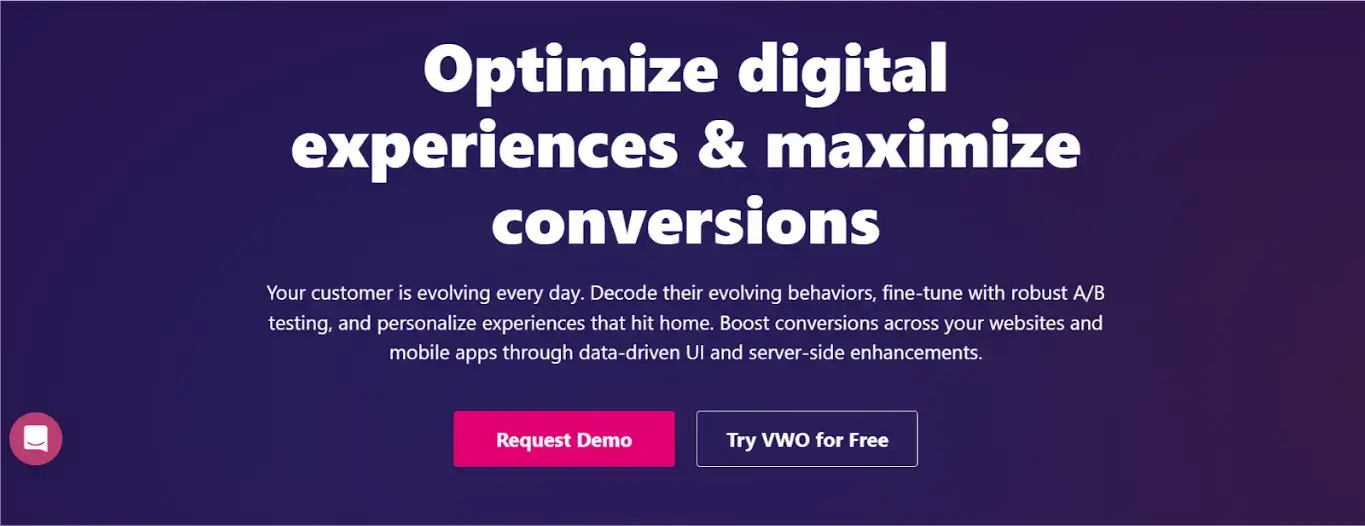
Pros:
- VWO includes features such as A/B testing, Integration testing, split URL testing, multivariate testing, heatmaps, session recordings, and on-page surveys for deeper insights. These features help you uncover hidden opportunities to increase conversions.
- VWO Insights allows you to view live data on user behavior, allowing you to make immediate adjustments or test different variations of your website elements. This iterative approach helps in continuously improving your conversion rates over time.
Cons:
- VWO Insights needs a lot of traffic to your store to gather meaningful data. If your website receives little traffic, it may take longer to generate actionable insights.
- It doesn’t integrate well with Google Analytics.
4. Mixpanel
Mixpanel is a robust analytics platform designed to help businesses understand user interactions and behaviors on their websites and mobile apps.
This tool provides granular insights into how users engage with your products or services, which allows you to optimize experiences and drive conversions.
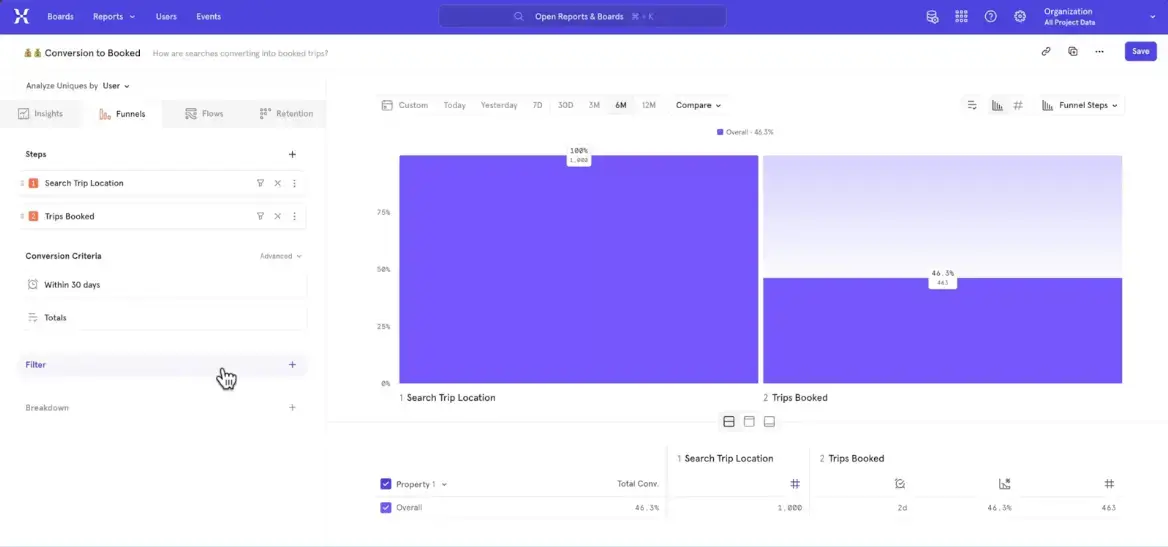
Pros:
- Mixpanel can track and analyze custom events, allowing you to define and measure the actions that contribute most to your goals. This will help you better understand your users’ pain points and journeys and uncover opportunities for improvement.
- This tool offers powerful segmentation features, allowing you to dissect your user data based on different attributes, behaviors, and demographics. This helps you create more personalized marketing assets.
- Mixpanel emphasizes cohort analysis, which allows you to group your users based on shared behaviors or characteristics and track their progress over time. This helps you understand user engagement, retention, and lifetime value.
Cons:
- The free forever plan and the Growth paid plan work well for small businesses, but depending on your needs, the enterprise-level plan can be too expensive.
- Mixpanel is not a ready-to-use solution. Your engineering team may need to set it up and configure it before using it.
5. CartFlows
CartFlows is a powerful sales funnel builder designed to optimize your WooCommerce checkout process and maximize conversions. By replacing the default checkout with a customizable, high-converting funnel, CartFlows helps you reduce cart abandonment and boost revenue effortlessly.
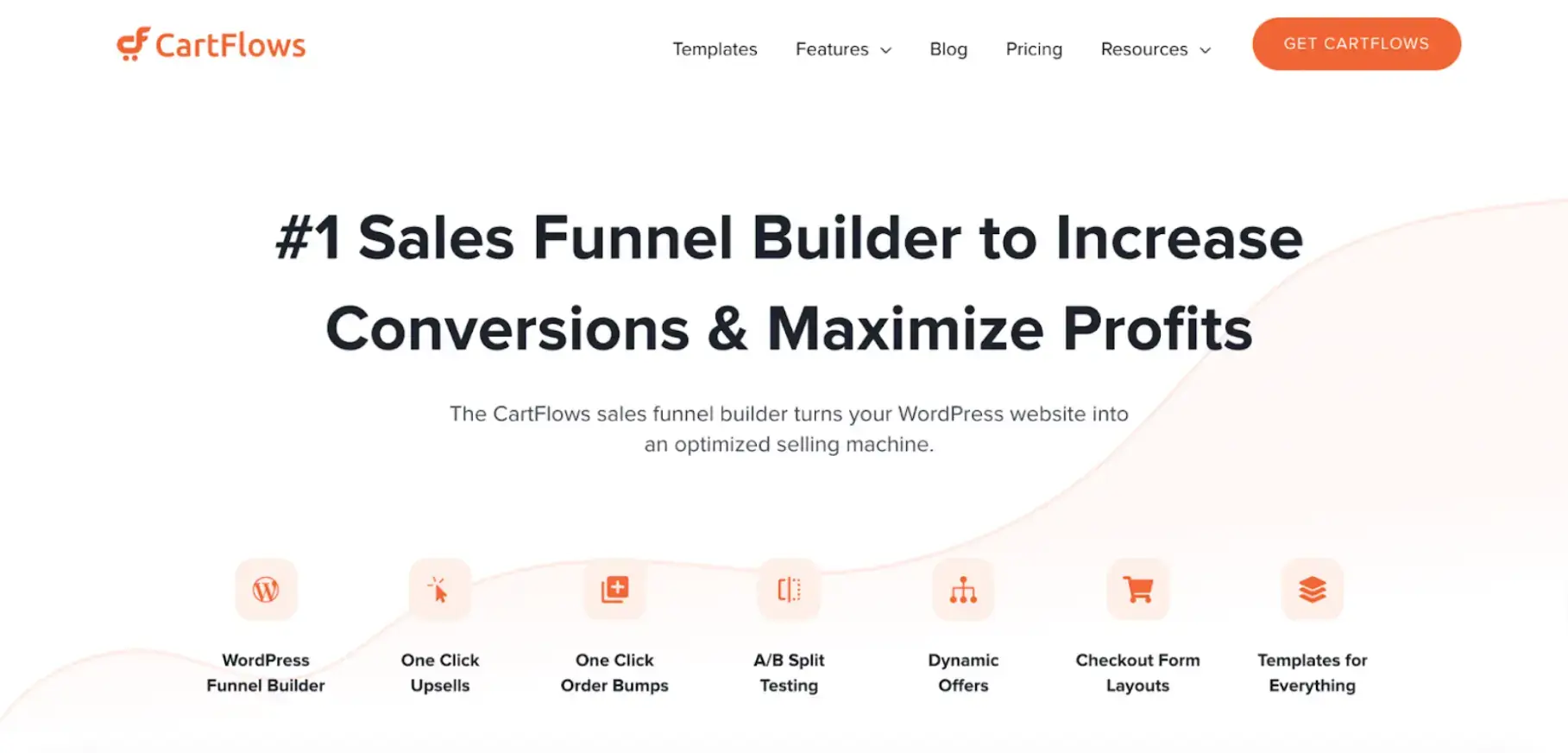
This tool lets you create seamless one-click upsells, order bumps, and dynamic checkout flows, allowing you to guide customers smoothly from browsing to purchasing. Whether you’re selling digital products, courses, or physical goods, CartFlows provides the tools you need to turn visitors into loyal customers.
Pros:
- Optimized Checkout Process – Customize and streamline the WooCommerce checkout experience to reduce friction and increase conversions.
- One-Click Upsells & Order Bumps – Boost average order value by offering relevant add-ons at checkout.
- Seamless Integration – Works with popular page builders, payment gateways, and automation tools.
Cons:
- Requires a WooCommerce setup, making it less ideal for non-WooCommerce stores.
- Advanced features may take time to fully configure for first-time users.
6. Hotjar
Hotjar is an all-in-one analytics and feedback tool that allows businesses to understand how users interact with their websites.
Hotjar provides a comprehensive view of user behavior through heatmaps, session recordings, surveys, and other features.

This information helps you identify areas of improvement in the website's design, layout, content placement, and overall user experience.
Pros:
- Hotjar visualizes user behavior through heat maps showing where users are clicking or scrolling the most on a webpage.
- Its intuitive interface makes it easy for users to set up and use various features.
- Compared to other CRO tools, Hotjar is affordable, making it accessible to small businesses with limited budgets.
Cons:
- Hotjar's free plan has limitations in terms of data storage and features available compared to its paid plans.
- While it provides valuable insights into user behavior patterns on websites at a macro level, it may not always provide the detailed individual-level data required for granular analysis.
7. Optimizely
Optimizely is a digital experience platform designed to help you test and experiment with your marketing assets to improve conversions.
This platform offers tools for A/B testing, multivariate testing, and personalization, making it a valuable asset for marketing and product teams.

Pros:
- Optimizely has a user-friendly interface and robust feature set that makes it accessible to users of varying technical backgrounds.
- This platform has an easily navigable visual editor that allows you to create and modify web page variations without coding knowledge.
This allows you to easily run tests at scale, refine user experiences, validate new features, and optimize conversion paths. - This platform supports advanced testing methodologies, including JavaScript testing, server-side testing, and URL testing. These methodologies allow you to test changes that might not be accessible with client-side testing alone.
- This tool offers robust analytics and reporting, which can give you insights into the performance of your experiments, visitor behavior, and conversion metrics.
Cons:
- There's no free trial or free version.
- Optimizely is extremely expensive (up to $60,000/year), so it's best suited for enterprise-level organizations.
- Integrating third-party data sources can be challenging.
8. Glassbox
Glassbox is a customer journey mapping tool that gives you comprehensive insights into your customers' online interactions and allows you to create seamless digital journeys for them.
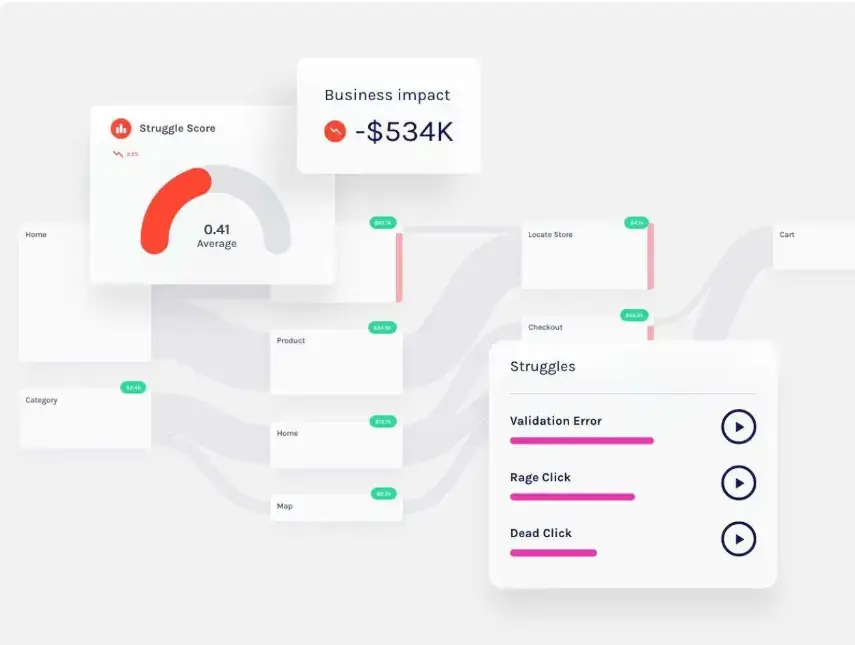
Pros:
- Glassbox records user sessions in real time, allowing you to navigate your website or online platform. This encompasses mouse movements, clicks, dynamic content changes, and form interactions.
- Glassbox allows you to create customer journey maps by aggregating your data into visual representations. This shows you the step-by-step depiction of how users navigate your website/app while highlighting key touchpoints and potential areas of improvement.
- This tool allows businesses to visualize and analyze these interactions through easily navigable dashboards and reports.
- Glassbox has robust security measures and compliance standards, which ensure the security of sensitive customer data and compliance with industry regulations.
Cons:
- Glassbox's pricing can be relatively high, especially for smaller businesses or startups with limited budgets.
- Depending on the existing tech stack of a business, integrating Glassbox may require technical expertise.
- Due to its ability to capture data extensively, Glassbox may generate a large volume of information. Without proper analysis and filtering, this data can become overwhelming and less actionable.
9. OptinMonster
OptinMonster is a lead generation platform that lets you create custom, personalized forms for capturing website leads. This makes it a popular choice for bloggers, marketers, and ecommerce businesses.

Pros:
- OptinMonster's versatile form builder allows you to create various opt-in forms, including floating bars, pop-ups, slide-ins, and more.
This allows you to match your forms to your branding. - This tool offers advanced segmenting and targeting options, allowing you to display different forms to various segments of your audience based on behavior, demographics, location, referral source, and more.
- This tool has a feature called Exit-Intent Technology, which triggers a form to appear when visitors are about to leave your website. This serves as a last-minute opportunity to grab their attention and convert them into paying customers.
- OptinMonster integrates with popular MarTech tools, including Mailchimp, MailerLite, Shopify, and WordPress.
Cons:
- Nearly one million websites use OptinMonster, so your popups may not stand out much to your audience.
- You need to connect with Google Analytics to see your stats.
10. Heap Analytics
At its core, Heap Analytics is a web and mobile analytics platform that automatically captures every

